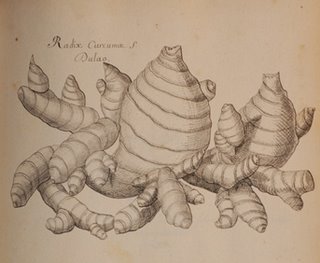josef george kamel, s.j. drawing of tumeric

Turmeric (Curcuma longa; dilao or dulao in Tagalog, langkawas in Visayan, lengkawas in Bahasa Indonesia) belongs to the ginger family and is similar in flavor to galangal (Alpinia galanga), the ubiquitous ingredient of Thai cuisine, which gives Thai dishes a bright yellow color and a gingery flavor with more bite.
This is the earliest illustration of tumeric that I have found in Philippine source materials (before 1706). It comes from the Kamel's Herbarium aliarumque stirpium in Insula Luzone Philippinarum Primaria Noscentium, a collection of some 270 botanical illustrations.
Culinary note: Tumeric is used in Philippine cuisine to flavor and color foods. In the Visayas, it is used for preparing flavored vinegar, called sinamak. Although there is no one formula as each cook swears the sinamak he or she prepares is the best, preparing sinamak is easy after you have gathered the basic ingredients.
The basic ingredients are: langkawas, bulb of the lemongrass, garlic, siling labuyo (short and small chili, similar to the Thai bird chili), pepper, salt and coconut vinegar. Tumeric is crushed or cut into small bits. Only the portion near the root (bulb) of the lemongrass is used. The hard dark green leaves are removed to expose the greenish white core. All the spices are placed inside a narrow-necked bottle, neatly arranged, then coconut vinegar is poured into the bottle using a funnel until all the spices are covered. The mixture is then left for a few weeks in a cool dry place to allow the spices to leach their flavors and blend with the vinegar. Coconut vinegar is fermented from tuba or palm toddy, which is made from the nectar of coconut flowers.
More of Kamel's illustrations will appear in this blog with comments on their current use in Asian and Filipino cuisine or in folk remedies.

0 Comments:
Post a Comment
<< Home